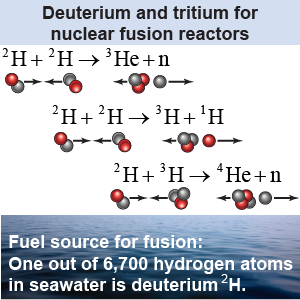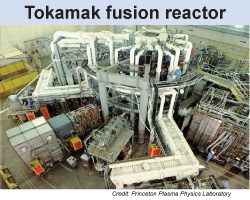|
The nucleus stores and is capable of releasing large amounts of energy as it converts mass to energy via Einstein’s mass–energy equivalence. The massive energies from nuclear phenomena have many applications in modern society, ranging from energy production to radiation therapy to medical and industrial noninvasive imaging. The decay properties of certain nuclei can also be used to target the deposition of their energy, such as in radiation therapy. 
|
Fusion energy
|
Since 1950 scientists and engineers have been working to design a fusion reactor that will make controlled production of fusion energy possible on Earth. In the Sun, the fusion reactions of the p–p cycle are driven by the pressure energy that is available in the extremely dense core of the star. The large mass of the Sun compresses the core to high densities, 150 times the density of ordinary water. On the Earth, however, it is not practical to achieve the same density as inside the Sun. As a result, if we want to initiate fusion reactions here on Earth, we must heat the fusion reactants to temperatures higher than the core of the Sun—higher than 16 million K! 
|
 Other fusion reactions are considered better candidates for nuclear power, but they generally require even higher temperatures than found in the Sun’s core. The most promising reactions involve deuterium, an isotope of hydrogen that has an extra neutron in its nucleus. Although deuterium is somewhat rare in seawater—0.016% of hydrogen atoms are deuterium—Earth’s massive oceans effectively provide a nearly inexhaustible supply of fuel. What is needed to create a practical fusion reactor on Earth that burns deuterium?
Other fusion reactions are considered better candidates for nuclear power, but they generally require even higher temperatures than found in the Sun’s core. The most promising reactions involve deuterium, an isotope of hydrogen that has an extra neutron in its nucleus. Although deuterium is somewhat rare in seawater—0.016% of hydrogen atoms are deuterium—Earth’s massive oceans effectively provide a nearly inexhaustible supply of fuel. What is needed to create a practical fusion reactor on Earth that burns deuterium? 
|
 High temperatures of 400 million K are required for a fusion reactor and have been achieved in the laboratory. The current engineering challenge is how to confine the hot, ionized gas for long enough so that the fusion reactions can proceed and generate enough usable energy. The tokamak design uses strong magnetic fields to confine the hot gas in a doughnut-shaped chamber. The inertial confinement design, in contrast, zaps tiny fuel pellets with powerful lasers to create many tiny, thermonuclear hydrogen explosions. Future research and development will show whether either the tokamak or inertial confinement methods can be made practical to construct a large-scale, commercial fusion reactor.
High temperatures of 400 million K are required for a fusion reactor and have been achieved in the laboratory. The current engineering challenge is how to confine the hot, ionized gas for long enough so that the fusion reactions can proceed and generate enough usable energy. The tokamak design uses strong magnetic fields to confine the hot gas in a doughnut-shaped chamber. The inertial confinement design, in contrast, zaps tiny fuel pellets with powerful lasers to create many tiny, thermonuclear hydrogen explosions. Future research and development will show whether either the tokamak or inertial confinement methods can be made practical to construct a large-scale, commercial fusion reactor. 
|
What is the difference between the two different kinds of fusion reactors currently being investigated?
 |
The tokamak design uses very strong magnetic fields to confine the fuel (a hot and ionized gas). The inertial confinement design uses lasers to heat the matter to high temperatures to initiate the reaction. 
|

